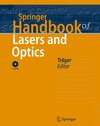
×
![Buchcover ISBN 9783642194085]()
From the reviews of the second edition:„Frank Träger has assembled a veritable who’s who of laser researchers … . In short, go out and buy this book; it is an excellent desk reference for researchers and research students. Undergraduates will find much to interest them, especially those contemplating entering the field. My only problem is where to hide my copy before my students think it should be on their shelf!“ (Barry Luther-Davies, Australian Physics, Vol. 44 (4), 2007)„This weighty work is intended to offer comprehensive and authoritative coverage of the wide fields of optics and lasers. … Overall text is clear, well written and accompanied by appropriate tables and diagrams. … The book’s content emphasis is very much on material suitable for the optical practitioner. … a worthy addition to stock for any library supporting physics at a university or specialist level.“ (Gareth J. Johnson, Reference Reviews, Vol. 22 (2), 2008)“I recommend this modern, comprehensive handbook to students, educators, engineers and scientists. The chapters are clearly written and include sophisticated illustrations that augment the text. The tables of data are also exemplary. The authors strike a good balance between the theory and implementation. The reader will appreciate the explanations of both the detailed mathematics and the physical aspects of the concepts. Each chapter contains pertinent references and an index.” (Barry R. Masters, Optics & Photonics News, November, 2012)
Springer Handbook of Lasers and Optics
herausgegeben von Frank TrägerThis new edition features numerous updates and additions. Especially 4 new chapters on Fiber Optics, Integrated Optics, Frequency Combs and Interferometry reflect the changes since the first edition.
In addition, major complete updates for the chapters: Optical Materials and Their Properties, Optical Detectors, Nanooptics, and Optics far Beyond the Diffraction Limit.
Features
Contains over 1000 two-color illustrations.
Includes over 120 comprehensive tables with properties of optical materials and light sources.
Emphasizes physical concepts over extensive mathematical derivations.
Chapters with summaries, detailed index
Delivers a wealth of up-to-date references.




